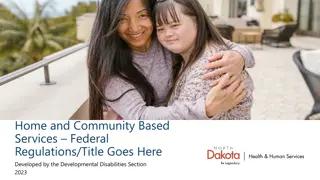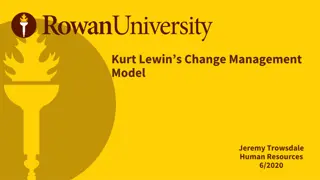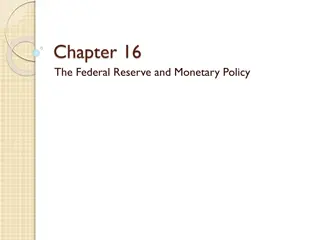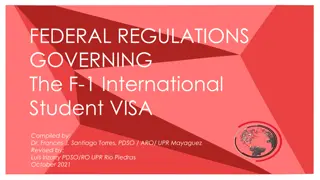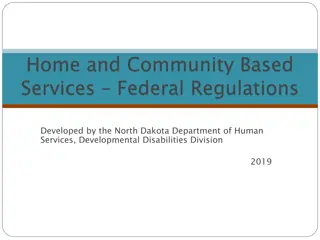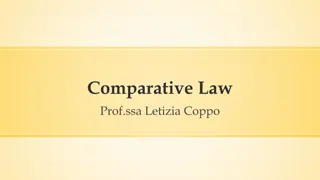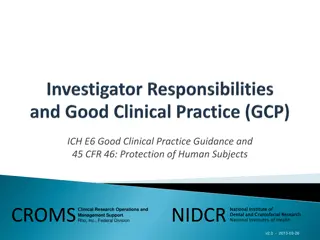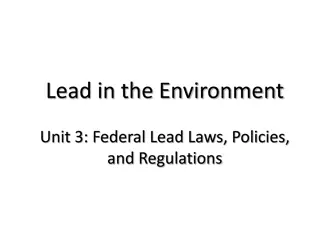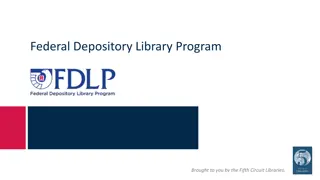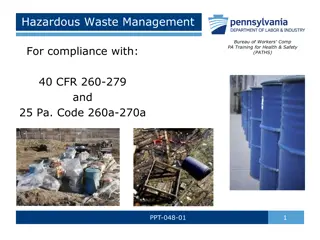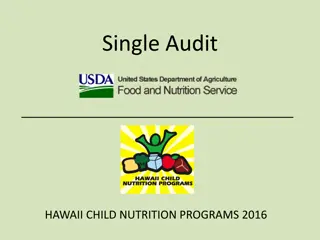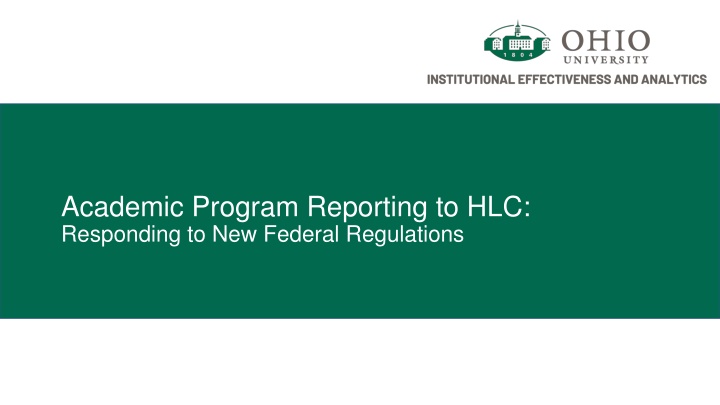
Responding to New Federal Regulations: Academic Program Changes and Guidelines
"Learn about academic program changes and guidelines in response to new federal regulations, including HLC requirements and definitions. Understand what is considered content, how to follow federal guidelines, and what is not considered content in academic programs."
Download Presentation

Please find below an Image/Link to download the presentation.
The content on the website is provided AS IS for your information and personal use only. It may not be sold, licensed, or shared on other websites without obtaining consent from the author. If you encounter any issues during the download, it is possible that the publisher has removed the file from their server.
You are allowed to download the files provided on this website for personal or commercial use, subject to the condition that they are used lawfully. All files are the property of their respective owners.
The content on the website is provided AS IS for your information and personal use only. It may not be sold, licensed, or shared on other websites without obtaining consent from the author.
E N D
Presentation Transcript
Academic Program Reporting to HLC: Responding to New Federal Regulations
New Guidance HLC Requirements for Changes to Existing Programs New Federal Regulations effective July 1, 2020 required changes to The Higher Learning Commission s (HLC, Ohio University s institutional accreditor) Substantive Change policies and processes including the changes to existing programs policies. Prior HLC approval may be required for substantive changes to existing academic programs including credit hours, program content, customized pathways, method of delivery (online or CBE), length of term affecting allocation of credit, or the cancellation or suspension of a program. Regulatory Reference: 34 CFR 602.22 HLC Policy: INST.F.20.040 Substantive Change and related policies
Academic Program, Federal Definition Glossary | General (hlcommission.org) Synonyms: academic offerings, program, educational program
What is considered content? Federal guidance on content: We meant a single change, or the sum total of the aggregate changes, to a program's curriculum, learning objectives, competencies, number of credits required, or required clinical experiences. This would include changes in the general education courses required for program completion and not merely the courses within the discipline, program, or major. See: https://www.govinfo.gov/content/pkg/FR-2019-11- 01/html/2019-23129.htm
Academic Program, Ohio University Following the Federal Definition: A program of organized instruction or study a program consists of all of the major, general education, and college requirements which lead to the academic credential sought. Open electives where students can freely choose any course to satisfy the requirement are NOT considered part of the content of a program, and only count toward the credit hour requirement of the program. Restricted electives where students must pick a course from a list of options ARE considered part of the content of a program. Synonyms: academic offerings, program, educational program
What is NOT considered content? Content is NOT; New course name Change of book assigned Length of semester Change of schedule, assessments, requirements, institutional policies on grading, honesty, etc. Department reorganization/name change
New Guidance on Program Change All program change calculations are CUMULATIVE since the last HLC Accreditation Action For OHIO, July 2019 Acceptance of our Systems Portfolio Next Accreditation Action 2024-2025 For institutions not on probation or sanction, we can choose to notify for <25%. If we do, they will track and determine when we reach 25% If we don t, we have to track the 25% threshold.
Six Types of Program Change 1. Substantially increasing or decreasing the number of credit hours (i.e., 25% or more) required for completion of a program. 2. Substantially changing the content of a program (i.e., 25% or more). 3. Addition of a program concentration, specialization, or track. 4. Customized pathways or modified or abbreviated courses or program. 5. Changing a program s method of delivery to distance education. 6. Cancellation or Suspension of any academic program.
Program ChangeCredit Hours 1. Substantially increasing or decreasing the number of credit hours (a cumulative 25% or more) required for completion of a program Prior HLC approval is required when the total number of credit hours for successful completion of a program increases or decreases by 25% or more since the most recent HLC accreditation review (currently July 2019). o Form required: Clock/Credit Hour Application o Review Process and Timeline: Desk Review, decisions within approximately 3 months of completed application.
Change in Credit Hours Examples o M.A. Degree A reduces their minimum credits to degree from 54 to 36. This is a reduction of 18 credit hours and is a 33% (18/54) change to the number of credit hours required for completion. o Certificate Program B increases the minimum credits required for completion from 9 to 12 credits. This is also a 33% (3/9) change to the number of credit hours required for completion. o Certificate Program C increases the minimum credits required for completion from 15 to 18 credits. This represents a 20% change and does not require prior approval. However, subsequently and prior to the next HLC accreditation review, the certificate reduces the credits back to 15. This represents and additional 17% change (3/18) in credits and since the threshold is cumulative 20% +17%=37% change in the minimum credit hours and prior approval is required.
Program ChangeContent 2. Substantially changing the content of a program HLC notification is required when an aggregate change of 25% or more to the content of a program (including both General Education and major requirements) since the most recent HLC accreditation review. o Form required: Screening form for changes to existing academic programs o Review Process and Timeline: Notification only, immediately upon receipt of the completed screening form. Undergraduate programs: The implementation of the new BRICKS General Education program must be considered in the CUMULATIVE calculation.
Change in Content Examples o A.A. Degree D requires a minimum of 60 credit hours and replaces 9 credit hours of required courses in the major. This change represents a 15% (9/60) change to the program and HLC does not need to be notified. The next year, a university- wide general education revision resulted in a change to three additional courses (9 credits) in the program to meet the new general education requirements. This results in a cumulative change of 15% + 15% = 30% change in the content of the program and HLC notification is now required. o M.S. Degree E requires a minimum of 30 credit hours consisting of 3 required courses for 10 credits, 3 additional courses selected from a list of 6 options for 10 total credits, and 10 additional credits. The program changes two of the required courses totalling 7 credits resulting in a change of 23% (7/30) of the required 30 credits. HLC notification is not required provided this is the only change to the curriculum since the last HLC accreditation action. o B.S. Degree G requires a minimum of 120 credit hours for degree completion. One degree requirement is to pick one 3 credit class from a list of 6 options. Two courses are added to this list of options. This results in a 33% (2/6) change in the content of the OPTIONS. Since the requirement is that one 3 credit class is selected this results in a 1% change in the content of the degree program explanation: if all 6 course options changed this would result in a maximum content change of 3% (3/120 credits). Since only 33% of these courses changed in this instance 3% x .33 =1% change to the program. THEREFORE, adding or deleting courses from a list of electives is unlikely to result in significant change to the content of a degree program and can usually be ignored in practice.
Program ChangeNew Concentration/Track 3. Addition of a program concentration, specialization, or track Definition of a program concentration: A program concentration (or specialization, track, or emphasis) involves less than half of the total hours in the program of which it is a part, with the remaining hours taken in common by all students in the program. If less than half of the total hours in the program are NOT taken in common, the program must be considered a distinct, new program. A concentration or specialization may be considered a significant departure from the original program approval based on a variety of factors, including, but not limited to, whether the institution plans to hire additional faculty with new expertise or to acquire specialized accreditation. Process: the institution s ALO should contact the institution s HLC Staff Liaison to determine whether HLC notification or prior approval is required.
Program ChangeCustomized Pathways 4. Customized pathways or modified or abbreviated courses or program Customized pathways or abbreviated or modified courses or programs to accommodate a student s existing knowledge (such as from employment or military service) and to close competency gaps between demonstrated prior knowledge and the full requirements of a particular course or program. Process: the institution s ALO should contact the institution s HLC Staff Liaison to determine whether HLC notification or prior approval is required. Form: Screening Form for Changes to Existing Academic Programs
Program ChangeAdding Online Modality 5. Changing a program s method of delivery to distance education OHIO has HLC s highest stipulation of approved to offer distance education courses and programs . Notification to HLC is required. Form: Screening Form for Changes to Existing Academic Programs
Program ChangeProgram Closure/Suspension 6. Cancellation of Suspension of any academic program Process: the institution s ALO should contact the institution s HLC Staff Liaison to determine whether HLC notification or prior approval is required. Form: Program Teach-out Notification Form if prior approval is not required. It is unlikely that prior approval would be needed.
New Academic Programs Prior HLC approval or notification may be required for new academic programs. When prior approval is required, institutions may not actively market, recruit, or enroll students into the prospective program until HLC has issued formal approval of the program in an official Action Letter. If APPROVAL is required HLC will notify the ALO after submission of the New Program Screening Form.
New Program Concentrations/Tracks A program concentration (or specialization, track, or emphasis) involves less than half of the total hours in the program of which it is a part, with the remaining hours taken in common by all students in the program. If <50% of the total hours in the program are taken in common, the program must be considered a distinct, new program. If 50% of the total hours in the program are taken in common, this will be considered a new program concentration and is considered under the Change to an Existing Program process.
Approval or Notification? Approval may be required if: The program is a significant departure from programs previously approved. For example, previously approved programs in the same 2 digit (XX.) or 4 digit (XX.XX) Classification of Instructional Programs Code (CIP). Are the hiring of new faculty in new areas of expertise needed to offer this program? Requires allocation of substantial financial investment or resources. Given the size of OHIO s budget, an individual program is unlikely to require a substantial financial investment. The new program will require the creation of a significant number of new courses or will require the hiring of significant numbers of new faculty.
New Program Screening Form If Notification is required: Once the ALO submits the New Program Screening form, HLC will either accept our Notification or indicate that a Substantive Change Form is required. If Approval is required: The ALO will provide the program contact with the correct Substantive Change form
Substantive Change: 3 Levels of Review Desk Review: Conducted by HLC staff Timeline: approximately 3 months Change Panel: Conducted by panel of three or more peer reviewers Timeline: approximately 6 months Change Visit: Conducted by two or more peer reviewers that includes an on-site visit to the institution Timeline: approximately 9 months
New Guidance on Modality Changes July 2020 Federal Regulations OHIO has highest level of Distance Education permissions Must notify HLC to changes to an existing program s method of delivery. January 2021 Dept of Ed retracts Dear Colleague Letter GEN-06-17 programs offered in whole or in part through telecommunications for purposes of Title IV Eligibility. Previously, 50% or more of a program s courses offered via distance education. Now, any program where one or more of the courses are offered via distance education. Even if a course is offered with both an online and in person option, that course counts as a distance education course.
Academic Program, Ohio University Following the Federal Definition: A program of organized instruction or study a program consists of all of the major, general education, and college requirements which lead to the academic credential sought. Open electives where students can freely choose any course to satisfy the requirement are NOT considered part of the content of a program, and only count toward the credit hour requirement of the program. Restricted electives where students must pick a course from a list of options ARE considered part of the content of a program. Synonyms: academic offerings, program, educational program
Distance Education Definitions Distance Education Course A course in which at least 75% of the instruction and interaction occurs using one or more of the technologies listed in the definition of distance education, with the faculty and students physically separated from each other. Distance Education Program An academic program offered in whole or in part through distance education, regardless of whether a face-to-face, on-ground, or residential option is available.
Change in Program Modality If a student in a program can take at least one major, college, or general education requirement as a distance education course even if an in-person option is available, that program is considered a distance education program and HLC must be notified. If a program no longer has at least one courses with an option to take the course as a distance education course, the program is not lingered offered through a distance education modality and HLC must be notified that OHIO is closing the distance education modality option.
Change in Program Modality Process If the program is already a distance education program: Program status will be reviewed at the end of the appropriate time period (see next slide) determined by the degree or credential. If the program no longer meets the definition of a distance education program, the ALO will notify HLC of the change in modality. If the program is NOT already a distance education program and intends to offer one of their courses (major, college, general education, certificate, etc.) online or via distance education, they must immediately notify the ALO. In other words, any course that would fulfill any requirement other than just total hours (a free elective) required for the program that is offered through distance education (e.g., online, OULN, video conferencing, etc.) must be reported to the ALO.
Time Period for Determining Distance Education Status If at least one course that is a program requirement (major, college, general education, restricted electives) is offered online in the following time period: Associate degrees Bachelor's degrees Undergraduate Certificates Masters: <40 credits >=40 credits Grad Certificates <15 credits >=15 credits Doctorate 7 years 3 years 6 years 6 years 6 years, 7 years 3 years or 4 years

